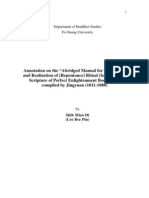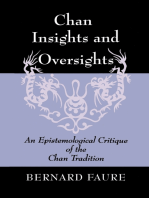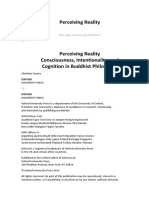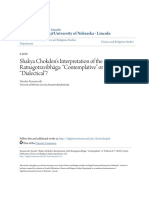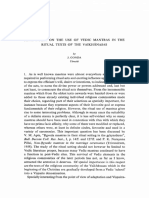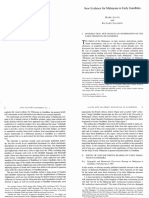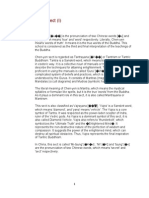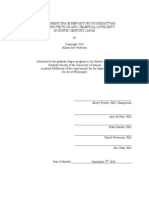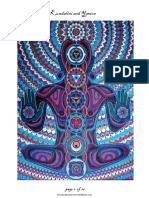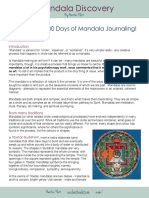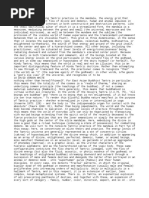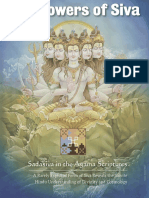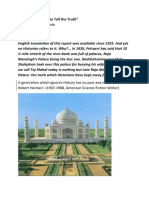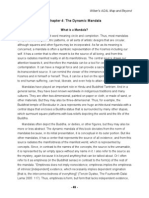Buddhist Studies: Journal of The International Association of
Buddhist Studies: Journal of The International Association of
Uploaded by
monkistCopyright:
Available Formats
Buddhist Studies: Journal of The International Association of
Buddhist Studies: Journal of The International Association of
Uploaded by
monkistOriginal Title
Copyright
Available Formats
Share this document
Did you find this document useful?
Is this content inappropriate?
Copyright:
Available Formats
Buddhist Studies: Journal of The International Association of
Buddhist Studies: Journal of The International Association of
Uploaded by
monkistCopyright:
Available Formats
53- + I \>ri
INSTITUT FUR TIBETOLOGIE UNO BUODHISMUSKUNDE
UNIVERSITATSCAMPUS A A K H , HOF 2
SPITALGASSG 2-4, A-1090 WIEN AUSTRIA. EUBOPE
Journal of the International Association of
Buddhist Studies
Volume 19 Number 2 Winter 1996 On Mandalas FRANK REYNOLDS Preface GER1 H. MALANDRA The Mandala at Ellora / Ellora in the Mandala CHARLES D. ORZECH Mandalas on the Move: Reflections from Chinese Esoteric Buddhism Circa 800 C. E. DAVID L.GARDINER Mandala, Mandala on the Wall: Variations of Usage in the Shingon School JACOB N. KINNARD Reevaluating the Eighth-Ninth Century Pala Milieu: Icono-Conservatism and the Persistence of Sakyamuni JOHN S. STRONG The Moves Mandalas Make 301 281 245 209 181 177
JOHN S. STRONG
The Moves Mandates Make
In 1895, L. Austine Waddell listed "magic-circles" (mandalas) as being among the "silly secrets," of Lamaism.1 Clearly, the study of mandalas has progressed a lot over the last one hundred years, and, judging from the papers published here, 2 it is continuing to evolve. Geri Malandra's "unfolding" mandalas at Ellora, Charles Orzech's ritually "unrolling" mandalas in Tang China, Jacob Kinnard's search for an "alternative man.dala" in P5la-period iconography, and David Gardiner's exploration of the overlap and "slippage" of mantfala symbolism at Koyasan in Japanall can stimulate us to new definitional reflections. One of the thrusts of these papers is to change the ways, or at least the contexts, in which we may view mancjalas by presenting them not just as well-ordered, clearly-delimited, pre-defined "cosmograms," 3 but as configurations that are "on the move" in more ways than one, and whose definitions must try to reflect those motions. This paper is a reworking of the "summary-response" I gave to the papers presented at the symposium entitled "Mandalas on the Move: Caves, Monuments and Icons Across the Buddhist World, ca. 750-850 C. E.," held April 21 and 22, 1995 at the Divinity School of the University of Chicago. I would like to thank Frank Reynolds for organizing the conference and for inviting me to speak. 1. L. Austine Waddell, The Buddhism of Tibet or Lamaism (London: W. H. Allen, 1895) 145. 2. All of these papers were presented to the symposium in Chicago. In addition, there was a paper (not included here) by Julie Gifford on Borobudur. Each paper was the focus of oral comments made by designated respondents, Robert Campany, Richard Cooler, John Holt, Geri Malandra, and Jonathan Walters. In what follows, I have tried to limit myself to a consideration of the four papers here published, although sometimes my citations of them will reflect their original versions presented to the symposium. Occasionally, also, I will make use of or refer to insights expressed at the symposium by some of the other participants, for which I thank them. 3. For a presentation of a number of such definitions of mandalas, see E. Dale Saunders, "Mandalas: Buddhist Mandalas," The Encyclopedia of Religion, ed. Mircea Eliade, vol. 9 (New York: Macmillan Co., 1987) 155-58. 301
302
JIABS 19.2
Of course, other scholars have been aware of the "movement" of mandalas, but, for the most part they have approached this topic within meditational, psychological or doctrinal contexts. For them, mandalas contain polyvalent richness and multidimensional symbolism, but they are more or less timeless, cultureless, and ahistorical "worlds in themselves."4 The papers presented here, however, seek to place mandalas themselves "in the world." They take seriously a number of contexts that are often neglected by other scholars. These include the historical, cultural, political, geopolitical, art historical, architectural, physical, ritual, and textual milieux which mandalas reflect and effect. In them, the nature of mandalas cannot be separated from time, space, politics, world views. My task, as I see it, is not so much to attempt to summarize these papers as to respond to their stimulus. I want to do this by taking seriously the title of the symposium and talking about the various ways in which the mandalas described in these papers are "on the move." I will center my remarks around four topics each reflecting a different sort of motion. Simply put: (1) mandalas themselves are moved; (2) mandalas make moves by rearranging relationships; (3) mandalas move other things over distance and time; and, finally (4), there is movement within mandalas. (1) First of all, mandalas can themselves be physically moved. The paradigmatic example here is that of Kukai literally bringing the two Shingon mandalas with him upon his return from China in 806. The significance of this act by this "first mover" is nicely put into its Japanese context in David Gardiner's paper. Yet as Geri Malandra suggests, there were probably other "Kukais" in other parts of the world, and the more local use 4. For a variety of examples of this genre, see Mircea Eliade, "Mandate," Yoga, Immortality and Freedom (Princeton: Princeton University Press, 1969) 219-27; Carl Gustav Jung, Mandala Symbolism, trans. R. F. C. Hull (Princeton: Bollingen Foundation, 1972); Minoru Kiyota, Shingon Buddhism: Theory and Practice (Los Angeles: Buddhist Books International, 1978), ch. 4; Michael Saso, Tantric Art and Meditation (Honolulu: Tendai Educational Foundation, 1990), chs. 2-3; David L. Snellgrove, Indo-Tibetan Buddhism, vol. 1 (Boston: Shambhala, 1987) 198-212; Adrian Snodgrass, The Matrix and Diamond World Mandalas in Shingon Buddhism, vol. 1 (New Delhi: Aditya Prakashan, 1988) 121-23; Ryujun Tajima, Les deux grands mandalas et la doctrine de Fesoterisme shingon (Tokyo: Maison Franco-Japonaise, 1959); Giuseppe Tucci, The Theory and Practice of the Mandala., trans. Alan Brodrick (London: Rider, 1961); Taiko Yamasaki, Shingon: Japanese Esoteric Buddhism (Boston: Shambhala, 1988) ch. 6.
STRONG
303
of movable mandates or mandate-like depictions by itinerant story-tellers has a long history throughout Asia.5 Mandates were thus part and parcel of the spread of Buddhism. They could be transported across continents or within communities, but in both cases their purpose seems to have been a pedagogic one: they attracted attention and communicated meaning whether at the popular or the esoteric level. Mandalas, of course, were not the only objects so moved and so used. KQkai himself brought back with him, along with the mandates and portraits of Chinese masters, various texts, ritual implements, Buddha relics, and images.6 Among these, the textsSanskrit manuscripts, Chinese surras and commentariescomprised by far the largest portion. It is interesting, therefore, to see what Kukai has to say about the pedagogic power of the mandalas in comparison to texts. The passage from his "Memorial,'' quoted by David Gardiner, may be paraphrased here: Esoteric teachings, according to Kukai, cannot easily be expressed in writing, but they can be completely captured and revealed in mandates, the simple sight of which can bring one to Buddhahood.7 Thus mandalas, unlike texts, are efficient tools that can more readily transmit at least esoteric teaching in toto. Truly they are pictures worth a thousand words. In this context, it may be interesting to compare, phenomenologically, Buddhist stories about the transportation of texts with stories about the movement of mandalas. Texts seem eminently more likely to be subject to loss or diminution in the course of transmission. Especially in the movement from India to China (which, it might be pointed out, also necessitated translationa further erosion not necessarily afflicting mandalas), texts sometimes seem to have been incapable of remaining intact, whole. The myth recounted by Charles Orzech is a case in point: the original Sarvatathagatatattvasamgraha found in the Iron Stupa was not transmitted to China, but instead a summary was sent, an "outline" that itself was "broad and long like a bed." But even this went overboard during a typhoon, and
5. For many examples of this oral genre, see Victor H. Mair, Painting and Performance: Chinese Picture Recitation and its Indian Genesis (Honolulu: University of Hawaii Press, 1988); on the identification of Chinese pien-wen as "mantfala-texts," however, see idem, Tang Transformation Texts (Cambridge, MA: Harvard University Press, 1989) 59-60. 6. This according to his "Memorial Presenting a List of Newly Imported Sutras and Other Items" (Shdrai mokuroku), trans. Yoshito S. Hakeda, Kukai: Major Works (New York: Columbia University Press, 1972) 140-50. 7. See ibid., 145-46.
304
JIABS 19.2
what ended up in China was a summary of a summary. 8 In the process, as Orzech points out, there occurred an "esoterization" of the text, the total teaching of which could now only be attained through initiation. In light of Kukai's comments, it might be possible to think of this as a "mandalization" of the text, a stripping of it down to its esoteric essence.9 Because this essence, according to Kukai, did not need elaboration and exegesis so much as viewing, i. e., realization, it may, in fact, have been more easily movable from one culture to another than exoteric traditions. This fact can help shed further light on Geri Malandra's claim that mandalas were an important part of making tantric Buddhism into an international movement." (2) Secondly, mandalas make moves by systematizing formerly disjunct elements of the culture or the religion. They give unity to multiplicity, and this in several different arenas. First of all, they synthesize in a new organized format structures that were nascent or not yet formed within the tradition. A clear example of this may be seen in David Gardiner's portrayal of the role played by Kukai and his newly imported mandalas in the process of creating a new "systematized" esoterism in Heian times out of an older "fragmentary" Nara esoterism. This was occasionally referred to at the symposium as "putting old wine into new bottles," but it might more appropriately be conceived of as "bottling what had been loose in barrels." A slightly more complex instance of this process may be found in Charles Orzech's analysis of the systematization, under Subhakarasirnha, Vajrabodhi and Pu-k'ung, of "piecemeal" mantra and dhdranl texts that had been flooding into China. Here, in his view, the new mandalaic structure provided by the Sarvatathagatatattvasamgraha was not single and static but modular and adaptable to the different demands of ritual situationsa notion that some discussants at the symposium dubbed as mandalas providing the basis for "ritual as jazz."10 Something similar, per8. There are many such Buddhist legends. For another famous example, Hsuan-tsang's loss of scriptures in a boat while crossing the Indus river on his way back home, see Li Rongxi, trans., A Biography of the Tripitaka Master of the Great Cien Monastery of the Great Tang Dynasty, BDK English Tripitaka 77 (Berkeley: Numata Center for Buddhist Translation and Research, 1995) 156 (= T 50: 249b, no. 2053). 9. It is interesting to recall here that one of the etymologies proposed for the word "man<Jala" is "seizing the essence." See Ferdinand D. Lessing and Alex Wayman, Introduction to the Buddhist Tantrica Systems (Delhi: Motilal Banarsidass, 1978) 270, n.l. 10. This point was first raised at the symposium by Robert Campany.
STRONG
305
haps, may be found in the iconographic context at Ellora, in the different "unfoldings" of the "shrine programs'* described by Geri Malandra. And yet another sort of synthesizing movement may be seen in Jacob Kinnard's analysis of the various ways in which the eight scenes of the astamahaprdtiharya "mandala," formalized during the Pala period, create a new totality that "epitomizes'' the whole of Buddhism. But mancjalas do not just synthesize previously disjunct elements within Buddhism, they also serve to syncretize Buddhist and "non-Buddhist" religious traditions, as well as Buddhist and state ideologies. Clearly, Buddhist esoterism, in its different cultural venues, interacted with a variety of other religious traditions: Brahmanism, Taoism, and Shinto, as well as "indigenous spirit cults." There was, of course, nothing new about this in the Buddhist world. It was, rather, the continuation of a trend, but it did affect the development of mandalas. Thus we find, for example, that elaborate compositions such as the Vajradhatu and the Mahakarunadhatu mandalas have incorporated into their halls gods, goddesses, and godlings that in a different context might be thought of as Hindu. More specifically, at Ellora (where Hindu and Buddhist patterns replicated and reinforced each other), Geri Malandra notes the presence of Bhudevi, the Earth goddess who testifies to Sakyamuni's merits when he is challenged by Mara. This is taken to be a reference to Bodhgaya and to the Buddha's conquest of Mara there, and as such, it may be compared to the bhumisparamudra images featured in Jacob Kinnard's discussion of the Pala period. But the conquest of Mara and the witness of the Earth goddess may also be seen as symbolic of the syncretism between Buddhism and indigenous divinities that everywhere accompanied the establishment of Buddhism in new locales.11 This theme is perhaps less pursued in the papers dealing with mandalas in East Asia, but it did not go unnoticed by the discussants at the symposium, several of whom emphasized the fact that the systematizations taking place in Tang China and Heian Japan need to be considered not only in the pre-existent Buddhist context, but in light of Buddhist-Taoist parallels on the one hand, and various cults of Shinto kami on the other.12 The question was posed, for example, of the relationship between mandalas and the nine-squared Ming Tang (Hall of Light), supposedly used by early
11. Bhudevi (Nang ThoranI) was to become especially important in Southeast Asia. 12. These points were particularly raised by Robert Campany and by Gary Ebersole.
306
JIABS 19.2
Chinese rulers.13 Elsewhere, Charles Orzech has suggested that Chinese mandates should be seen in light of the "Taoist" Ho-t'u and Lo-shu cosmograms as well as the Chinese philosophical categories of li and chih.14 A second type of syncretic movement going on in mandalas is that between Tantric Buddhism and state ideologies. Thus, as has often been recognized, the rituals and structures of mandalasin India, Tang China, and Heian Japanwere in part stimulated by and helped reinforce political concerns. As Charles Orzech points out, two goals dominated Esoteric Buddhism in Tang times: the rapid attainment of enlightenment and the protection of the state. Similarly, at Ellora, Geri Malandra suggests that the depiction of royal figures might reflect "an early record of royal participation in a mandala... ritual.*1 At the same time, however, she goes further to propose that Ellora as a whole, and the esoteric Buddhism it nurtured, be viewed in the geopolitical context of a nascent "world system" that saw Indian Ocean civilisations as part of an "entire structure" defined in part by Islam. This is an important point. On the one hand, it may help correct the generally dominant perception of pan-Asian Buddhism as a continental culture with a view of it being also a maritime tradition. On the other hand, it may alter the way in which we see mandalas themselves. From this perspective, mandalas are not only cosmograms; they also paradoxically embody both a totality that is the whole and a totality that is "less than the whole." Because of their political connections, they are graphs of palaces, capital cities, kingdoms, empires, from a ruler's perspective. They are thus privileged places, and are often marked off by gateways, boundaries, guardians. Socially, they might be called "aristograms." In terms of state ideology, these very demarcations set them off and mean that they have to be seen not just as "the whole cosmos" but as units operating within a greater world system. In this regard, it may be worth remembering that when the Lotus Sutra lists various types of kings, it uses the word "mandalin" not to denote a cosmic king, but to identify a more minor ruler, one who governs only a single region. The mandalin, who controls a "mandala," is thereby distinguished from a cakravartin who rules all four continents (i. e., everything) and a bala-
13. For an interpretation of the Ming Tang, see the still useful Marcel Granet, The Religion of the Chinese People, trans. Maurice Freedman (New York: Harper and Row, 1975) 67. 14. See Charles D. Orzech, "Chen-yen," The Encyclopedia of Religion, ed. Mircea Eliade, vol. 3 (New York: MacMillan Publishing Co., 1987) 236.
STRONG
307
cakravartin who rules over only one.15 A mana'ala may constitute a world, but it can also be a world within the world. (3) A third set of moves made by mandalas lies in the fact that they make present the absent Buddha. By this I do not mean only that, as the Mahavairocana sutra puts it, a mandala is "what gives birth to all Buddhas," i. e., that it provides a matrix for enlightenment, for the development and maturing of bodhicitta.16 Mandalas do not only make meditators into Buddhas, they also are able "magically" to transpose the Buddha through time and space to the present here and now. I am using the word "magic" here in the sense employed by Paul Mus in his Barabudur. Mus's focus was on the stupa rather than the mana'ala, but he saw both as "mesocosms," a term he created to mean a "place of passage,"17 "a magical structural milieu"18 that can "overcome the absence of objects or persons . . . wherever they might be or no longer be." 19 The primary "absent" person, of course, was the Buddha in Nirvana, a concept "so ungraspable that one can only propose for it a formula bristling with contradictory negations."20 According to Mus, it was in order to cut through this "excessively subtle logic" that Buddhists turned to magical and cultic practices focused on mesocosms "so as to assure themselves of satisfactions and certainties of an affective order, without which there is no religion."21 The "mandala as mesocosm," however, would appear to "make the Buddha presenf in several particular ways. First of all, it can overcome the barrier of distance by transposing to itself the site (and hence the event) of the Buddha's enlightenment at Bodhgaya. This is most explicitly stated by Geri Malandra who convincingly connects Ellora with Bodhgaya even 15. Hendrik Kern and Bunyu Nanjio, ed., Saddharmapundarlka sutra (St. Petersburg, 1912) 6,20, 363. Kern {The Lotus of the True Law [Oxford: The Clarendon Press, 1884] 7, 20, 343) translates "mandalin" as "governor of a region." Eugene Bumouf (Le Lotus de la bonne loi [Paris: Imprimerie Nationale, 1852], p. 4, n.l has "roi d'un pays." 16. See on this, Snodgrass, 120, 122. The original citation may be found in T. 848, 18: 5. 17. Paul Mus, Barabudur, vol. 1 (Hanoi: Imprimerie d'Extreme-Orient, 1935) 100. 18. Ibid.,94. 19. Ibid.,14. 20. Paul Mus, "La mythologie primitive et la pensee de l'lnde," Bulletin de la Sociite" Francaise de Philosophie 37 (1937): 91. 21. Ibid.
308
JIABS 19.2
calling it the "Bodhgaya of the South." But more generally, of course, every mancjala could be seen as the Vajrasana. The transposition of Bodhgaya and other "central" Buddhist sites where the Buddha had lived and taught to localities on the periphery was not an uncommon phenomenon in the Buddhist world. Thus, according to certain local traditions, the various sacred places of Magadha could be found reduplicated in Gandhara,22 in Yunnan,23 and in Southeast Asia.24 Even as far away as Japan, the tradition developed that it was no longer necessary to travel to India because the sites most intimately associated with the Buddha (and thus the Buddha himself) could be found right there in Japan, at the SennyO-ji temple in Kyoto, for example,25 or at the Kasuga shrine in Nara.26 These views recall the words of the Maharashtrian saint quoted by Geri Malandra to the effect that there is no need to go anywhere, because every place worth visitingin this context, those places where the Buddha can be foundhas been made present right at home. Mancjalas thus can make pilgrimages unnecessary because they move the center to the periphery, thereby transforming it into a place of the Buddha. It may be, however, that that "center" is not always located on this earth. Thus the Buddha's dwelling place could be thought of not as Bodhgaya but as a Pure Land or as one of the heavens. Here too, however, the mandala can serve to make present that distant site. Alex Wayman, for instance, describes a text in which "the mandala can be understood to represent the palace of the Akanistha heaven, where . . . Gautama was initiated as a Complete Buddha."27 By entering into the manclala, bodhisattvas could thus find themselves in the Akanistha heaven and receive instruction from the Buddha himself (in his sambhogakaya).28 22. See Edouard Chavannes, "Voyage de Song Yun dans TUdyana et le Gandhara," Bulletin de lEcole Franqaise dExtreme-Orient 3 (1903): 381-87 23. See Paul Pelliot, "Deux itineraires de Chine en Inde a la fin du Vile siecle," Bulletin de^Ecole Franqaise d Extreme-Orient 4(1904): 161-62 24. See Michael Aung-Thwin, "Jambudlpa: Classical Burma's Camelot," Contributions to Asian Studies 16(1981): 38-61. 25. See John S. Strong and Sarah M. Strong, "A Tooth Relic of the Buddha in Japan: An Essay on the Sennyu-ji Tradition and a Translation of Zeami's No Play 'Shari'," Japanese Religions 20 (1995): 15 26. See Robert E. Morrell, "Passage to India Denied," Monumenta Nipponica 37 (1982): 192-93. 27. Alex Wayman, "Symbolism of the Marujala Palace," The Buddhist Tantras (New York: Samuel Weiser, 1973) 91. 28. Ibid.
STRONG
309
Secondly, the "mandate as mesocosm" can overcome the barrier of time, and here the directions it takes can be several. On the one hand, the orientation may be to the past, and the mandala may act as the milieu for a transposition to the life and time of the Buddha Sakyamuni. Such a move lies at the heart of the icono-conservatism described by Jacob Kinnard, with its freezing in time the sequence of eight scenes from the biography of the founder. This is akin to a "move to Bodhgaya" but the metaphor is temporal rather than spatial. On the other hand, the orientation may be to the future, and the mandala may enact a projection to the presence of the Buddha Maitreya who is yet to come. Such a move does not figure in the papers published here but was much emphasized in Julie Gifford's presentation to the symposium on 'The Place of Maitreya in the Borobodur Mandala." The same theme, perhaps, may be found at present day Koyasan where Kflkai and many others lie waiting for Maitreya in the midst of the mandala-like cemetery at the Okuno-in, or more explicitly at Kasagidera, not far from Nara, where the original presence of the future Maitreya was preserved in what is now called the "Kasagi mandara."29 At the same time, of course, the mandala as mesocosm can eschew both the past and the future and seek the Buddha in the "eternal," finding him in figures such as Aksobhya and / or Vairocana. (4) Finally, we come to what might be called "movements within the manQ*ala " I want to address this by speaking in terms of several different "oscillations," which are not unconnected to the movements we have discussed so far, but present them in a different light. These oscillations are the result of a mandala's inherent multivalence: as one pole of significance within the mandala is emphasized, there is a tendency for it be counterbalanced and replaced by the opposite pole. The first oscillation concerns the question of the identity of divinities within the mandala. Here I would like to return to the ambiguity pointed out in Jacob Kinnard's paper between 5kyamuni and Aksobhya, both of whom are represented as figures in bhumisparsamudra.30 Kinnard cites Nancy Hock's view that this is an "intentional ambiguity," a "dual nature" reflective of a transitional stage epitomized by 5kyamuni in a tantric 29. See Karen L. Brock, "Awaiting Maitreya at Kasagi," Maitreya, the Future Buddha, ed. Alan Sponberg and Helen Hardacre (Cambridge: Cambridge Uni versity Press, 1988) 214-47. 30. The same ambiguity between Sakyamuni and Aksobhya can be found in Southeast Asia, as was pointed out by Richard Cooler at the symposium.
310
JIABS 19.2
form.31 There is thus some oscillation here between Tantra and non-Tantra within the mandala. This could also be viewed as an oscillation between different bodies of the Buddha or different levels of understanding: in a certain sense, Sakyamuni is Aksobhya; in another he is not. In a slightly different context, it is similarly possible to state that all the divinities in the two great Shingon mandalasthe Taizokai and the Kongokaiare finally none other than Vairocana (Dainichi Nyorai) who occupies the center of both of them. Here too, there may be constant opportunities for oscillation. For example, in the first level abhiseka rite mentioned by David Gardiner, the kechien kanjo meant to "establish a bond" between the initiate and a particular deity of the mandala, the blindfolded candidate must toss a flower onto the surface of the mandala; the particular divinity on whom the flower lands thereby takes on a special importance and is established in a tutelary relationship (embodied in an esoteric name) with the initiate.32 In the midst of the ritual, however, at least in the Tendai tradition, as soon as the flower is thrown, the name "Dainichi Nyorai" (Vairocana) is shouted out by the attendant priests, regardless of what particular divinity or bodhisattva the flower falls on. This is because all deities in the mandala are Vairocana.33 A second oscillation may be found in the structure of the Kongobuji at Koyasan as described by David Gardiner: was the plan for one stupa or two stupas? Was the intention to map out on the landscape of the mountain two mandalas in distinction or overlapping as one? 34 The ambiguity, of course, may be due to such mundane matters as the lack of funds or materials for buildings, but it nicely captures an oscillation that is perhaps also summed up in the Japanese expression "ryobufuni" meaning the two paired mandalas are "not two"i. e., not different from each other. This 31. See Nancy Hock, "Buddhist Ideology and the Sculpture of Ratnagiri," diss., University of California, Berkeley, 1987. 32. For brief descriptions of the ceremony, see Tajima, 271; Snodgrass, 732. 33. I owe this detail of "oral tradition* to the late Michel Strickmann, with whom I visited the hall set up for the abhiseka in Yokawa, on Mount Hiei, in 1977. It may also be due to the fact that these initiations can be seen as repetitions of Kukai's abhiseka. When Kukai was initiated, his flower landed on the image of Dainichi Nyorai both timesin the Taizokai and the KongOkai mandalas. See Snodgrass, 732. 34. A similar oscillation may be found in the mountains of the Kii peninsula where, for Japanese yamabushi, Mount Kimpu (near Yoshino) represents the Kongokai, the Kumano peaks represent the Taizokai, and Mount Omine represents the superimposition of both mandalas. See Carmen Blacker, The Catalpa Bow (London: Unwin, 1986)211-12.
STRONG
311
paradoxical assertion, of course, reflects an oscillation of major importance to the whole Tantric tradition: the twin emphasis on Wisdom and Compassion. Thus the Taizokai mandala is traditionally taken to show the unfolding womb of the Buddha's compassion and the Kongokai mandala the penetrating power of his wisdom. But even within the Kongokai, there can be a double motion: a centrifugal one spinning out compassion from the center and a centripetal one seeking wisdom by spiralling inward.35 Elsewhere, as in the case of the monument of Borobudur, this double motion may be thought of as ascending (to enlightenment) and descending (to this world of suffering).36 In each instance, there is a realization within the motion of the mandala of the duality-yet-unity of Nirvana and samsara, that forms such a crucial part of Mahayana Buddhism and of Tantra in particular. One might recall here David Snellgrove's distinction between the "vertical core" of the mandala in which stages of realization and reality are distinguished, and the "horizontal mandala" which is "an idealized representation of the identity of nirvana and samsara."37 Finally, these papers bring to light a third kind of movement within the mantfala that might be described as an oscillation between the inside and the outside. Simply put, in this context, what one finds when one penetrates into the center of the structure is the structure. Some of this may be found in Geri Malandra's paper in which "the mandala is at Ellora," and "Ellora is in the mandala," but the full dimensions of this oscillation are perhaps best seen in David Gardiner's discussion of the relationship of stupa and mandala. At Koyasan, what one finds inside the mandala is the stupa and what one finds inside the stupa is the mandala. In so far as the stupa may represent the Buddha's absence and the mandala his "active presence in our world," this also represents an oscillation between absence and presence. But other elementstexts and bodiesmay enter into this game of tantric leapfrogging. The Great Stupa at Koyasan is sometimes identified with the Iron Stupa in India which, as was pointed out, was the source of texts that were the source of mandates, but which here in Shingon is also "this very body in which one realizes Buddhahood" (sokushin jobutsu), which
35. See Daigan and Alicia Matsunaga, Foundation of Japanese Buddhism, vol. 1 (Los Angeles: Buddhist Books International, 1974) 189. 36. This was one of the insights from Julie Gifford's paper not published here. 37. D. L. Snellgrove, The Hevajratantra, vol. 1 (London: Oxford University Press, 1959) 29.
312
JIABS 19.2
Buddha body is a stupa, which is a mandala. Truly the word "mandala" means a "circle" in more than the usual sense of the term.38 One could probably keep going round and round on the meaning of mandalas which themselves are not static entities, and which are in constant interaction with the contexts that inform them. But enough has been said, I think, to show that there is much to be learned from the approaches taken in these four papers. Though dealing with very different situations in very different parts of Asia,39 they nonetheless make it possible to think of 8th9th centuries in pan-Buddhist terms.
38. The model for all this may well be an Indian one rooted in Brahmanical traditions of sacrifice, in which the sacrifice itself creates the gods, creates the priests, creates the texts, creates the structure that creates the sacrifice . . . The necessity of thinking about mandalas in the context of srauta rites was emphasized by John Holt at the symposium. 39. It should be noted that no paper was presented to the symposium on mandalas on the move in Tibet or in Mainland Southeast Asia or in Nepal, a fact that was noted and regretted.
You might also like
- Guitar Building Plans Les PaulDocument6 pagesGuitar Building Plans Les Paulmonkist78% (9)
- Mandalas: The Matrix and Diamond World in Shingon BuddhismDocument5 pagesMandalas: The Matrix and Diamond World in Shingon BuddhismmonkistNo ratings yet
- Les Paul Special Blueprint PDFDocument1 pageLes Paul Special Blueprint PDFmonkistNo ratings yet
- Drewes, D. Early Indian Mahayana Buddhism I - Recent ScholarshipDocument11 pagesDrewes, D. Early Indian Mahayana Buddhism I - Recent ScholarshipvkasNo ratings yet
- RepentanceDocument45 pagesRepentancesampah858No ratings yet
- Zheng Wei Hong On Buddhist LogicDocument9 pagesZheng Wei Hong On Buddhist LogicParkerNo ratings yet
- Eds 1275 Double Neck SG BlueprintDocument1 pageEds 1275 Double Neck SG BlueprintmonkistNo ratings yet
- Danner F09 CatalogDocument27 pagesDanner F09 Catalogmonkist100% (1)
- 50 Verses of Guru DevotionDocument33 pages50 Verses of Guru DevotionCittamaniTara100% (1)
- Jiabs 19-2Document140 pagesJiabs 19-2JIABSonline100% (2)
- Book Review: Traditional Theravada Meditation and Its Modern-Era SuppressionDocument5 pagesBook Review: Traditional Theravada Meditation and Its Modern-Era SuppressionensantisNo ratings yet
- Staal Happening PDFDocument24 pagesStaal Happening PDFВладимир Дружинин100% (1)
- Chan Insights and Oversights: An Epistemological Critique of the Chan TraditionFrom EverandChan Insights and Oversights: An Epistemological Critique of the Chan TraditionRating: 4 out of 5 stars4/5 (3)
- Apoha: Buddhist Nominalism and Human CognitionFrom EverandApoha: Buddhist Nominalism and Human CognitionRating: 5 out of 5 stars5/5 (1)
- Trimsika Nance Rev PDFDocument61 pagesTrimsika Nance Rev PDFtgerloffNo ratings yet
- Controvesies On The Origine of AbbhidhammaDocument8 pagesControvesies On The Origine of AbbhidhammaHoang NguyenNo ratings yet
- A Preliminary Study of The Meaning of Yoga in Sangharaksa's Yogacarabhumi and Its ContextDocument59 pagesA Preliminary Study of The Meaning of Yoga in Sangharaksa's Yogacarabhumi and Its ContextGuhyaprajñāmitra3No ratings yet
- Jiabs 24-1Document134 pagesJiabs 24-1JIABSonline100% (2)
- The Tathagata Garbha SutraDocument13 pagesThe Tathagata Garbha SutrapatxilNo ratings yet
- Bhamati CatussutriDocument647 pagesBhamati CatussutriAshwin Kumble100% (1)
- Kragh 2002a - The Extant Abhidharma-Literature PDFDocument50 pagesKragh 2002a - The Extant Abhidharma-Literature PDFdedi_shenNo ratings yet
- Buddhist Epistemology and Research in Buddhist StudiesDocument14 pagesBuddhist Epistemology and Research in Buddhist StudiesMattia SalviniNo ratings yet
- Jiabs 2-2Document128 pagesJiabs 2-2JIABSonline100% (1)
- Maps of Ancient Buddhist IndiaDocument40 pagesMaps of Ancient Buddhist IndiaSameera Weerakoon100% (2)
- PDFDocument61 pagesPDFAigo Seiga CastroNo ratings yet
- Bronkhorst - Karma and Teleology PDFDocument118 pagesBronkhorst - Karma and Teleology PDFAshay NaikNo ratings yet
- Jiabs 19-1Document176 pagesJiabs 19-1JIABSonline100% (1)
- Indian Buddhist Treatises MadhyamkaDocument10 pagesIndian Buddhist Treatises MadhyamkaErickson SantosNo ratings yet
- Christian Coseru-Perceiving Reality - Consciousness, Intentionality, and Cognition in Buddhist Philosophy-Oxford University PresDocument355 pagesChristian Coseru-Perceiving Reality - Consciousness, Intentionality, and Cognition in Buddhist Philosophy-Oxford University PresAxinciucNo ratings yet
- Bronkhorst 1985Document16 pagesBronkhorst 1985Bair PuigNo ratings yet
- 01 Early BuddhismDocument9 pages01 Early BuddhismAshin TejobhasaNo ratings yet
- Shakya Chokden's Interpretation of The Ratnagotravibhāga: "Contemplative" or "Dialectical"?Document13 pagesShakya Chokden's Interpretation of The Ratnagotravibhāga: "Contemplative" or "Dialectical"?Thomas LeorNo ratings yet
- Brill's Encyclopedia of Buddhism: LivesDocument8 pagesBrill's Encyclopedia of Buddhism: Lives1011760% (1)
- UtrechtDocument31 pagesUtrechtAigo Seiga CastroNo ratings yet
- The Buddhist Translation Histories of Ancientchina (C. 150-1276) and Tibet (C. 617-1750) : Acomparative StudyDocument21 pagesThe Buddhist Translation Histories of Ancientchina (C. 150-1276) and Tibet (C. 617-1750) : Acomparative StudyJigdrel77No ratings yet
- Jikido Takasaki - The Tathagatagarbha Theory in The Mahaparinirvana-Sutra (Paper)Document10 pagesJikido Takasaki - The Tathagatagarbha Theory in The Mahaparinirvana-Sutra (Paper)thewitness3No ratings yet
- Tucci 1935 A Propos The Legend of NāropāDocument13 pagesTucci 1935 A Propos The Legend of NāropāCyberterton4No ratings yet
- The Transmission of Buddhist Astral Science From India To East Asia: The Central Asian ConnectionDocument17 pagesThe Transmission of Buddhist Astral Science From India To East Asia: The Central Asian ConnectionBill M. MakNo ratings yet
- Meaning of VijnaptiDocument20 pagesMeaning of VijnaptiAadadNo ratings yet
- Digitization of Buddhist TextsDocument23 pagesDigitization of Buddhist TextsMin Bahadur shakyaNo ratings yet
- Dignag Anvaya VyatirekaDocument20 pagesDignag Anvaya Vyatirekaapi-3701246No ratings yet
- JIBS - TathagatotpattisambhavanirdesaDocument6 pagesJIBS - TathagatotpattisambhavanirdesaAadadNo ratings yet
- Abhidharmakośabhā Ya (Treasury of Metaphysics With Self-Commentary)Document16 pagesAbhidharmakośabhā Ya (Treasury of Metaphysics With Self-Commentary)wintwarNo ratings yet
- Salomon R. Allon M.-New Evidence For Mahayana in Early GandharaDocument12 pagesSalomon R. Allon M.-New Evidence For Mahayana in Early Gandharashu_sNo ratings yet
- RUKMANI - Dharmamegha-Samandhi in The Yogastras of PatañajaliDocument10 pagesRUKMANI - Dharmamegha-Samandhi in The Yogastras of PatañajaliNicoSobrievisNo ratings yet
- Vaikhanasa Daily Worship1Document5 pagesVaikhanasa Daily Worship1NK PKNo ratings yet
- Jiabs 12-1Document171 pagesJiabs 12-1JIABSonline100% (1)
- Vyakhyayukti 9178 9469 1 SMDocument55 pagesVyakhyayukti 9178 9469 1 SMLy Bui100% (1)
- The Doctrine of Amalavijnâna in Paramârtha Radich MichaelDocument131 pagesThe Doctrine of Amalavijnâna in Paramârtha Radich MichaeljdelbaereNo ratings yet
- Review of U.T. Kragh Ed. The FoundationDocument6 pagesReview of U.T. Kragh Ed. The FoundationShim JaekwanNo ratings yet
- Nihom, Max Vajravinayā and Vajraśau ADocument11 pagesNihom, Max Vajravinayā and Vajraśau AAnthony TribeNo ratings yet
- The Genesis of The Five Aggregate TeachingDocument26 pagesThe Genesis of The Five Aggregate Teachingcrizna1No ratings yet
- Basanta Utsav in Black & White - MuktodharaDocument10 pagesBasanta Utsav in Black & White - MuktodharaAmit PaulNo ratings yet
- Alikakaravada RatnakarasantiDocument20 pagesAlikakaravada RatnakarasantiChungwhan SungNo ratings yet
- Gregory Schopen - The Text On The "Dhāra Ī Stones From Abhayagiriya": A Minor Contribution To The Study of Mahāyāna Literature in CeylonDocument12 pagesGregory Schopen - The Text On The "Dhāra Ī Stones From Abhayagiriya": A Minor Contribution To The Study of Mahāyāna Literature in CeylonƁuddhisterie2No ratings yet
- Is The Buddha Like A Man in The Street Dharmakīrti's AnswerDocument31 pagesIs The Buddha Like A Man in The Street Dharmakīrti's AnsweryogacaraNo ratings yet
- Bharthari and His Vedic Tradition PDFDocument16 pagesBharthari and His Vedic Tradition PDFDrn PskNo ratings yet
- Rein Raud-Dogen Idea of Buddha-Nature - No Referencialismo & DinamicaDocument14 pagesRein Raud-Dogen Idea of Buddha-Nature - No Referencialismo & DinamicaFilosofia2018No ratings yet
- Royal Asiatic Society of Great Britain and Ireland Is Collaborating With JSTOR To Digitize, Preserve and ExtendDocument3 pagesRoyal Asiatic Society of Great Britain and Ireland Is Collaborating With JSTOR To Digitize, Preserve and ExtendsrimahakalaNo ratings yet
- Jiabs 6-1Document181 pagesJiabs 6-1JIABSonline100% (1)
- Kellner Taber 2014 Yogacara Idealism IDocument48 pagesKellner Taber 2014 Yogacara Idealism Irob100% (1)
- Senn 1339Document30 pagesSenn 1339CojdepHaitiNo ratings yet
- Bodiless Gnostic Body PDFDocument16 pagesBodiless Gnostic Body PDFalbertmelondiNo ratings yet
- Castes in India - Damodar K. MavalankarDocument3 pagesCastes in India - Damodar K. Mavalankarxenocid3rNo ratings yet
- Buddhist Philosophy of Language in India: Jñanasrimitra on ExclusionFrom EverandBuddhist Philosophy of Language in India: Jñanasrimitra on ExclusionNo ratings yet
- Mortality and Mercy in Vienna: Epoch (Cornell Univ.) Vol IX, No. 4Document12 pagesMortality and Mercy in Vienna: Epoch (Cornell Univ.) Vol IX, No. 4monkistNo ratings yet
- Red Wing Heritage Europe: Spring/Summer 2 0 1 4Document4 pagesRed Wing Heritage Europe: Spring/Summer 2 0 1 4monkistNo ratings yet
- Mortality and Mercy in Vienna: Epoch (Cornell Univ.) Vol IX, No. 4Document12 pagesMortality and Mercy in Vienna: Epoch (Cornell Univ.) Vol IX, No. 4monkistNo ratings yet
- BSA Temp InsigniaDocument7 pagesBSA Temp InsigniamonkistNo ratings yet
- Redwing Lifestyle CatalogDocument39 pagesRedwing Lifestyle CatalogmonkistNo ratings yet
- 13 RH94234 Heritage FW13 NA Workbook LoresDocument28 pages13 RH94234 Heritage FW13 NA Workbook LoresmonkistNo ratings yet
- 15 RH94234 Heritage FW NA 1214 LoresDocument28 pages15 RH94234 Heritage FW NA 1214 LoresmonkistNo ratings yet
- Feature-Packed Mining Boot: FootwearDocument12 pagesFeature-Packed Mining Boot: FootwearmonkistNo ratings yet
- 2011.04.04 USListDocument123 pages2011.04.04 USListmonkist100% (1)
- 1950s Les Paul PDF BlueprintDocument1 page1950s Les Paul PDF BlueprintmonkistNo ratings yet
- Catalog RedWingShoes 2011Document52 pagesCatalog RedWingShoes 2011monkistNo ratings yet
- Simatic Pniopcac AssertionDocument2 pagesSimatic Pniopcac AssertionmonkistNo ratings yet
- Microsoft Office 365 CertsDocument14 pagesMicrosoft Office 365 Certsmonkist33% (3)
- Dell Power Edge R310 Spec SheetDocument2 pagesDell Power Edge R310 Spec SheetmonkistNo ratings yet
- Chen YenDocument16 pagesChen Yenmonkist100% (1)
- Danner Uniform Catalog 2012Document72 pagesDanner Uniform Catalog 2012monkist100% (1)
- Danner Boots Recrafting FormDocument1 pageDanner Boots Recrafting FormmonkistNo ratings yet
- The Formation of Early Esoteric Buddhtsm in JapanDocument311 pagesThe Formation of Early Esoteric Buddhtsm in Japanmonkist100% (2)
- Everest GearDocument2 pagesEverest GearmonkistNo ratings yet
- Religious Rituals in ShugendoDocument16 pagesReligious Rituals in ShugendomonkistNo ratings yet
- The Mandala of The Two RealmsDocument93 pagesThe Mandala of The Two Realmsmonkist100% (4)
- Samantabhadracharya Pranidhana - Samantabhadra Aspiration PrayerDocument28 pagesSamantabhadracharya Pranidhana - Samantabhadra Aspiration PrayermonkistNo ratings yet
- Pedersen Ku 0099D 11218 DATA 1Document304 pagesPedersen Ku 0099D 11218 DATA 1monkistNo ratings yet
- Inner Work Self ForgivenessDocument5 pagesInner Work Self ForgivenessSkara C100% (1)
- 5th Grade Lesson Plan - MandalasDocument6 pages5th Grade Lesson Plan - Mandalasapi-272644242No ratings yet
- MAPPING THE UNIFIED-FIELD THE BLUEPRINT FOR CREATION For World Mysteriescomhh Alex SokolowskiDocument23 pagesMAPPING THE UNIFIED-FIELD THE BLUEPRINT FOR CREATION For World Mysteriescomhh Alex SokolowskiChristine100% (5)
- Kundalini and Yantra PDFDocument16 pagesKundalini and Yantra PDFRavi Teja ChillaraNo ratings yet
- The Tantra of The Blue-Clad Belssed VajrapaniDocument55 pagesThe Tantra of The Blue-Clad Belssed VajrapaniFelipe AndraNo ratings yet
- Ritual Meditations - TendaiDocument8 pagesRitual Meditations - TendaiMonge Dorj75% (4)
- Chapter - III: 1. Place of Symbolism and It's RelevanceDocument71 pagesChapter - III: 1. Place of Symbolism and It's Relevanceindrani royNo ratings yet
- A Safe Guide For The Practitioner of Hevajra TantraDocument8 pagesA Safe Guide For The Practitioner of Hevajra TantraRandy HoweNo ratings yet
- A Holmes Reader On Meaning by Ernest Holmes CDocument22 pagesA Holmes Reader On Meaning by Ernest Holmes CKira Morgan100% (2)
- Importance of Chaitya Culture in The Present Situation of Nepal MandalaDocument6 pagesImportance of Chaitya Culture in The Present Situation of Nepal MandalaPragyaNo ratings yet
- Jayakrishnan - Kavitha / Dancing ArchitectureDocument114 pagesJayakrishnan - Kavitha / Dancing Architectureboomix100% (1)
- Kaal ChakraDocument99 pagesKaal ChakraLordgrg GhotaneNo ratings yet
- Từ Điển Phật Học Việt Anh - Vần T - Minh ThôngDocument94 pagesTừ Điển Phật Học Việt Anh - Vần T - Minh ThôngYêu Tôn GiáoNo ratings yet
- Skorupski, T. - Sarvadurgatiparisodhana Tantra (Vol. 1)Document151 pagesSkorupski, T. - Sarvadurgatiparisodhana Tantra (Vol. 1)the Carvaka100% (2)
- Mandala DiscoveryDocument77 pagesMandala DiscoveryDon'tBotherMe X100% (3)
- Vastu Purush MandalaDocument2 pagesVastu Purush Mandalasdg0808100% (1)
- Tantric MandalaDocument4 pagesTantric MandalaYugal ShresthaNo ratings yet
- Signs and Symbols (PDFDrive) PDFDocument383 pagesSigns and Symbols (PDFDrive) PDFPiyush AgarwalNo ratings yet
- Mandalas and YantrasDocument14 pagesMandalas and YantrasVictoria VignatiNo ratings yet
- Brahma Mandala of PrambananDocument41 pagesBrahma Mandala of PrambananUday DokrasNo ratings yet
- Brought Here by DR Uday Dokras: Sabharathnam SivacharyarDocument9 pagesBrought Here by DR Uday Dokras: Sabharathnam SivacharyarudayNo ratings yet
- Five Powers of Siva EiDocument10 pagesFive Powers of Siva EidbbircsNo ratings yet
- Taj Mahal - Time To Tell The Truth ? - Is The Taj A Hindu Palace Temple - Asks DR GodboleDocument38 pagesTaj Mahal - Time To Tell The Truth ? - Is The Taj A Hindu Palace Temple - Asks DR GodboleAron AroniteNo ratings yet
- Kubla KhanDocument3 pagesKubla KhanTANBIR RAHAMAN0% (2)
- Create Your Own MandalaDocument24 pagesCreate Your Own MandalaNorman Morales100% (1)
- Aleister Crowley, Myth and MagickDocument17 pagesAleister Crowley, Myth and MagickMogg Morgan100% (2)
- 2 - Week 4-5Document15 pages2 - Week 4-5Rhealyn RobledoNo ratings yet
- Druk White Lotus SchoolDocument20 pagesDruk White Lotus SchoolSadhana Patil100% (1)
- Chapter 4: The Dynamic Mandala: What Is A Mandala?Document18 pagesChapter 4: The Dynamic Mandala: What Is A Mandala?Nabin BajracharyaNo ratings yet




